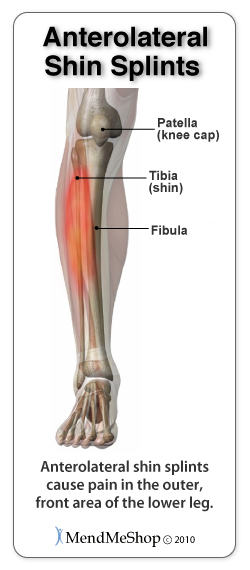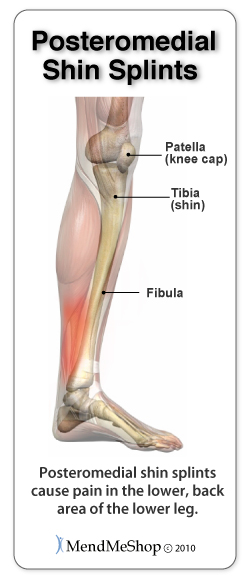|
|
Shin SplintsAnterolateral Shin Splint, Posteromedial Shin Splint
A shin splint is a painful condition that occurs from damage to muscles along the shin, and the pain can occur anywhere from just below the knee to above the ankle. The typical cause is continued, repeated stress to the lower leg, and is common in runners. Shin splints may be caused by:
Anterolateral Shin Splints Anterolateral shin splints affect muscles in the front and outside parts of the shin, and is the result of a natural imbalance in the size of opposing muscles. Shin muscles pull the foot up, whereas the large and powerful calf muscle pulls the foot down every time the heel strikes the ground when running. These calf muscles can exert a lot of force, enough force that can actually injure the shin muscles. Anterolateral shin splints will cause pain in the front and outside of the shin. Initial pain is felt when the heel strikes the ground though eventually the pain just stays constant. To allow this type of shin splint to heal, the person must stop running and do other kinds of exercise recommended by their doctor or physical therapist. Such exercises usually involve stretching the calf muscle, as tight calf muscles put a lot of pressure on the shin muscle and tendons. A constant regimen of Circulation Boost is commonly recommended to help the affected muscles and tendons to become more elastic, allowing them to heal more quickly and reduce inflammation and pain in the area. Treatment of the calf muscle with the Leg TShellz Wrap® will also help increase the flexibility as well as elongate this muscle; this will reduce the level of strain on the shin muscle and tendon group and as such decrease the chance of re-injury and allow the injury to heal more quickly. Posteromedial shin splints Posteromedial shin splints affect muscles in the back and inner part of the lower leg. These muscle groups are responsible for lifting the heel to support the runners weight on the ball portion of the foot when running. This type of shin splint is often caused by running on a banked track or non-level running surface or wearing improper shoes that do not protect the foot from rolling (pronation). Pain begins on the inside of the lower leg (usually within 7 inches above the ankles), but will worsen and continue to rise up the leg. Initially, only tendons of the muscles will become inflamed, but if running continues, the muscles themselves could become affected. At the worst, the tendon could become detached from the bone - a painful occurrence that causes bleeding and excessive inflammation. To allow a posteromedial shin splint to heal, the runner must temporarily stop running and do other kinds of exercise recommended by their doctor or physical therapist. Special shoes may be prescribed during the healing phase, and it may be advisable to look into potential problems with pronation of the feet. This can often be solved by researching and using shoes that better prevent pronation and/or the avoidance of running on side slopes. Tips on Tendinitis The strained tendon is a common yet painful injury that will occur in almost everyone at least once in their lifetime. The trick with a strained tendon is to make sure it heals properly which will provide the lowest chance of re-injury. Re-injury of a strained or stressed tendon occurs more easily than the first time and there is usually much more inflammation around a re-injured tendon than there was during the first occurrence of the injury. Tendonitis is a degenerative condition in the tendon fibers that attach muscles to bone, and sufferers generally complain of a severe, burning pain in the area, which gradually worsens and is exacerbated by stress on the joint. If you got it from a workout, heavily reduce your workout intensity (eliminate it altogether if possible) through the healing stage, and make sure the injured tendon be warmed up (and down) properly before and after a workout where it will be stressed. Product Advisors are available 9:00 am to 5:00 pm Eastern Standard Time Monday to Friday. Learn More About Tendon Injuries & TreatmentsI want to learn more about Post-Surgery Recovery I want to learn more about TShellz Wrap® Circulatory Boost I want to learn more about Ice & Heat: Which Is Better For Treatment? I want to learn more about Tendonitis Treatments I want to learn more about Tendonitis Surgery FREE SHIPPING ON ALL PRODUCTS CURRENTLY ENABLED |
    |
